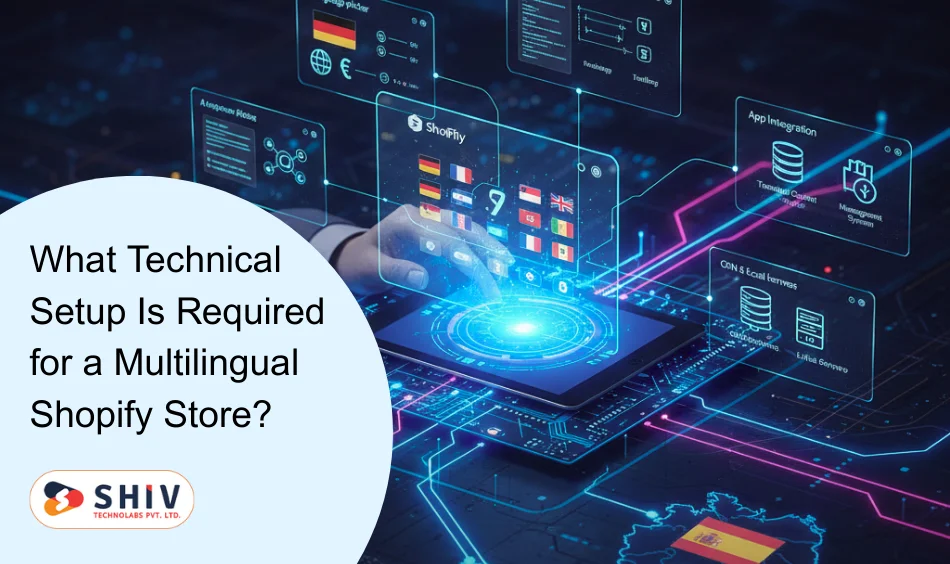Table of Contents
A multi-language ecommerce website helps brands win buyers across Germany, France, and Spain with local-first content. Companies planning ecommerce website development in Europe build trust faster when shoppers read familiar terms and country-specific service details.
A Multilingual ecommerce website reduces hesitation at checkout and shortens the path to purchase for every regional audience. German shoppers expect precise details, transparent taxes, and strong returns pages with clear timelines and policies. French buyers value rich descriptions, localized reviews, and delivery information that sets correct expectations before payment.
Spanish customers respond well to concise copy, mobile-ready pages, and straightforward payment steps during peak seasons. Local tone, pricing, and support lift engagement and reduce drop-offs across common retail categories measurably. Our team plans content and checkout paths that convert interest into paid orders across key categories.
Work with specialists who map search demand, write local product copy, and set up accurate tax display for each market. We integrate trusted gateways, country-specific delivery rules, and support scripts that reduce pre-checkout drop-offs and refund risk.
Why Localization Matters in Europe
- Native language builds trust and lowers cart abandonment.
- Payment preferences differ and need clear support across regions.
- SEO grows with country-specific keywords and localized metadata.
- Local returns, VAT display, and delivery terms reduce doubts.
- Cultural cues and formats raise time on page and average order value.
What Makes a Multi-Language Ecommerce Website High-Converting?
High-converting stores remove friction and guide visitors with simple choices, fast feedback, and predictable checkout steps. Start with quick page loads, a visible language switcher, and tax-inclusive prices backed by consistent VAT messaging. Add localized trust signals near the primary button, including delivery windows, region reviews, and support hours.
Personalized content improves intent when it reflects real buyer needs rather than generic copy or broad claims. Show region-based promotions, local shipping badges, and payment options that match familiar methods, providers, and cards. Use concise banners to highlight holiday schedules and city-level delivery speeds during peak European seasons.
When UX follows local habits, visitors spend longer, add more items, and finish purchases without second-guessing. A multilingual Shopify store makes this practical with focused apps, clear architecture, and performance at scale. Your multi-language ecommerce website then turns first-time visitors into repeat buyers with fast, transparent checkout steps.
Pair fast pages with concise templates that highlight benefits, specs, and returns near the main action on mobile. Track add-to-cart rates, checkout step drops, and conversions by country to sharpen messages and remove friction quickly. Report insights weekly and apply targeted changes that lift intent and final conversions across every active market.
How Do Language and Localization Impact Online Store Performance in Europe?

Language and localization shape how shoppers find, read, and buy across Europe’s largest markets today. Brands focused on ecommerce website development in Europe gain loyalty when pages match native terms and buying habits. That foundation raises trust across key categories and prepares each market for focused campaigns.
A multi-language ecommerce website removes guesswork during product research and the final checkout steps online. Clear copy, local reviews, and relevant delivery windows keep visitors confident, engaged, and ready to convert. You remove friction at decision points and help visitors finish orders with confidence.
Translate menus, filters, and search labels so shoppers move quickly to the right products without confusion. Show country prices, tax display, and shipping promises in language that matches customer expectations for each market. Small improvements here often lead to stronger product views and more completed carts.
Localization Elements That Boost Sales
- Geolocation-based content – show country pricing, delivery windows, and taxes by market.
- Translated navigation – clear menus, filters, and on-site search in the visitor’s language.
- Local payment options – support iDEAL, Klarna, PayPal, and trusted cards at checkout.
- GDPR and legal compliance – present consent, policies, and data requests in the correct language.
Measure country-level add-to-cart rates, checkout drop-offs, and refund reasons to guide improvements week after week with dashboards. Use those insights to adjust copy, highlight local reviews, and refine delivery promises for peak seasons.
What Are the Must-Have Features of a Multilingual Shopify Store for European Retailers?
A multilingual Shopify store gives retailers practical tools for languages, currency, and regional checkout rules. With the right setup, teams publish translations, display correct taxes, and keep pages fast across Europe. That structure supports growth campaigns while keeping catalogs clean and merchandising consistent across markets over time.
Professional configuration prevents data drift and reduces costly rework as catalogs and campaigns grow rapidly. Work with a Shopify store design agency in Germany to define templates, translation workflows, and tax logic that scale. You gain predictable launch cycles, faster approvals, and clear ownership for ongoing language updates company-wide.
Build a package that covers translation QA, country content calendars, and analytics by region for every quarter. Add review workflows, return messages, and support scripts so buyers receive clear answers in their language. Link these processes to ad platforms and email journeys, so promotions and content match local demand.
Essential Shopify Multilingual Features
- Shopify Markets – manage countries, domains, duties, and pricing rules from one place.
- Translation apps (Langify, Weglot) – translate product data, menus, and metadata with review workflows.
- Multi-currency management – show prices, tax display, and rounding rules aligned with each market.
- Regional shipping options – map delivery methods, times, and costs to local carriers and zones.
We configure these features, validate them with test orders, and hand over simple playbooks for updates.
How Much Does It Cost to Build a Multilingual Ecommerce Website in Europe?
Here’s a practical view of building a multi-language ecommerce website for Europe’s top markets. To compare budgets, consider Shopify development costs in Germany, France, Spain, and the scope for each launch. Numbers below reflect typical first builds with clean design and core integrations for European checkout and catalog management.
| Country | Estimated Cost (EUR) | Time Frame |
|---|---|---|
| Germany | €6,000 – €15,000 | 5–8 weeks |
| France | €6,000 – €14,000 | 5–8 weeks |
| Spain | €6,000 – €13,000 | 5–8 weeks |
Budgets change with language count, catalog size, and translation method across product pages, filters, and navigation labels. Custom templates, app licenses, and QA for checkout flows add costs but reduce rework during future campaigns.
Payment and tax setup in each country affects time, especially when you configure duties, VAT display, and refunds. Complex shipping rules, returns portals, and carrier integrations also stretch timelines for cross-border orders and warehouse routing.
For speed, launch with essential languages, core categories, and the checkout features your first regions need most. Add richer content, automation, and language variants after you confirm demand and stable conversion across priority markets.
Our team plans country rollouts, sets clear budgets, and delivers weekly tracking against the milestones you approve. You get accurate cost control, faster go-live dates, and a build that supports growth across Europe.
Post-launch, we handle updates, translation checks, and campaign landing pages for peak seasons and country events. You scale content and product lines without risking broken menus, duplicate tags, or mismatched prices by market.
Which Platform Is Best for Building Multilingual Ecommerce Websites in Europe?
For multilingual builds, teams often weigh Shopify, WooCommerce, and Magento for speed, control, and upkeep. With Shopify store development, European projects move faster, since apps cover languages, currency, and tax display at scale.
| Platform | Multilingual Support | Setup Complexity | EU Compliance | Overall Score |
|---|---|---|---|---|
| Shopify | Built-in via apps | Easy | Strong | ★★★★★ |
| WooCommerce | Plugins required | Moderate | Average | ★★★★☆ |
| Magento | Custom setup | Complex | High | ★★★☆☆ |
Shopify pairs hosted speed with a mature app stack, which shortens timelines and reduces maintenance risk. WooCommerce offers strong control through plugins but needs careful updates, security checks, and server tuning. Magento suits complex catalogs, yet custom setup and upkeep often demand larger budgets and specialist teams.
Pick based on launch speed, catalog depth, and internal capacity for updates and QA over time across regions. If your goal is fast expansion across Germany, France, and Spain, Shopify usually provides the clearest path for teams today.
What Technical Setup Is Required for a Multilingual Shopify Store?

A multilingual Shopify store needs a clean structure, fast delivery, and accurate country targeting across every page. Start with a content model that supports translated products, menus, filters, and policy pages for each market. Add QA steps that confirm language, taxes, and shipping details before you switch traffic live.
Map domains or subfolders to countries so shoppers land on the right language without confusion or extra clicks. Match analytics events to locales so your growth team reads conversion by market with clear signals. A multi-language ecommerce website then scales faster because content, prices, and checkout logic remain consistent.
Technical Setup Checklist for Shopify Multilingual Stores
- Language selector configuration
- Hreflang tags & translated metadata
- Regional subfolders (/de, /fr, /es)
- CDN & caching for European performance
How to Improve SEO and Conversion for Multi-Language Ecommerce Websites in Europe?
Brands focused on ecommerce website development in Europe win reliable traffic when pages match local queries and search intent. Build topic clusters for each country, then connect category, product, and policy pages with internal links. A multi-language ecommerce website performs better when metadata, copy, and schema reflect native terms.
Pair content gains with conversion lifts by placing local reviews, delivery windows, and returns near key actions. Test short headlines and region offers on mobile because most buyers start journeys there. Track add-to-cart rates and checkout drops by country, then update copy weekly to remove friction.
SEO Optimization Tips
- Hreflang tags
- Meta translation
- Structured data per region
Conversion Optimization Tips
- A/B testing localized CTAs
- Testimonials from each region
- Country-based trust seals
Why Choose Shopify for Multi-Language Ecommerce Website Development in Europe?
Teams pick Shopify when launch dates matter and upkeep must stay predictable. With Shopify store development in Europe, you get proven tools for languages, currency display, duties, and VAT handling. A multilingual Shopify store keeps pages quick on mobile and gives your merchandisers clean workflows.
Hosted performance helps during sales peaks, national holidays, and heavy ad bursts. Your staff ships updates on a fixed cadence and avoids server chores that slow busy calendars. Catalog rules, pricing, and tax notes stay aligned, so campaigns land cleanly across Germany, France, and Spain.
You also gain an app stack built for translation review, local payments, and policy pages in native terms. This approach shortens testing windows and reduces last-minute fixes before go-live. Marketing teams read clearer data by country, which speeds approvals and trims wasted spend.
If you want scale without messy rework, Shopify offers a practical path. Pages stay light, checkout stays clear, and daily tasks are easy to train. That mix supports new market launches and keeps operations steady throughout the quarter.
Why Shopify Works Best for European Businesses
- Easy localization
- EU payment methods (Klarna, PayPal, iDEAL)
- VAT and data compliance
- Scalable for B2C/B2B
What’s the ROI of a Multi-Language Ecommerce Website for European Retailers?
A multi-language ecommerce website drives lift because shoppers see their language, their price format, and their trusted payment logos. They read product copy without guesswork and finish orders with fewer doubts. These small wins add up across regions and lower the cost of each sale.
Track what moves profit, not vanity metrics. Watch country traffic, add-to-cart rate, step-level checkout drops, refunds, and repeat orders. Use those signals to tighten copy, clarify taxes, and adjust delivery promises before peak events. Keep tests short, measure weekly, and roll improvements into your country playbooks.
Retention grows when post-purchase emails, return steps, and support hours appear in the right language. Local reviews near the main action help new buyers decide faster on mobile.
ROI Benefits of a Multilingual Store
- 30–40% increase in regional traffic
- Reduced bounce rate
- Higher lifetime customer value
FAQs on Multilingual Ecommerce Website Development in Europe
What is the average cost to build a multilingual ecommerce website in Europe?
Most first builds land here: Germany €6,000–€15,000, France €5,000–€12,000, Spain €4,000–€10,000. Extra languages, complex shipping, and custom templates raise spend.
How many languages should a Shopify store have for Germany, France, and Spain?
Launch with German, French, and Spanish. Keep English as a fallback, then add variants when demand and team capacity grow.
Does Shopify support multiple currencies for EU markets?
Yes. Shopify Markets supports multi-currency pricing, duties, and VAT display, with PayPal, Klarna, and iDEAL via trusted apps.
How long does it take to develop a multilingual Shopify store?
Plan three to eight weeks. Design scope, translation readiness, tax logic, and carriers set the final timeline.
Is Shopify the best option for multilingual ecommerce websites in Europe?
Shopify suits fast, low-maintenance builds. WooCommerce and Magento fit heavier custom work; choose based on budget, control, and skills.
Conclusion
Local language, clear pricing, and fast checkout raise trust across Germany, France, and Spain. A focused build removes friction and supports reliable campaigns during seasonal pushes and country-specific events. With Shiv Technolabs as your partner, you launch on schedule, control costs, and keep progress steady week by week.
If you need a shopify development company in Europe, our team can plan, build, and support your rollout. We set targets, track results, and hand over simple playbooks for ongoing changes. Contact us today for a free consultation and get a country-by-country plan for growth.






















